The loss of natural roosting habitats has led to an increase in bats using man-made structures as a home for their colonies. Whether you’re planning a bat exclusion from an attic or another building on your property or just want to attract bats to eat mosquitos or other insects, a bat house is a great way to keep them around without bats becoming a nuisance.
How Bats Become Pests
Bats are a keystone of many ecosystems for their ability as pollinators and natural ways to control insect populations. A single bat will eat between three hundred to three thousand insects a night.[1]
If bats are living in your attic or another part of your home, you may be tempted to do whatever you can to get rid of them fast, however, bats are protected by many laws, so it is important to follow certain procedures and guidelines when trying to get rid of them.
Why Bat Houses
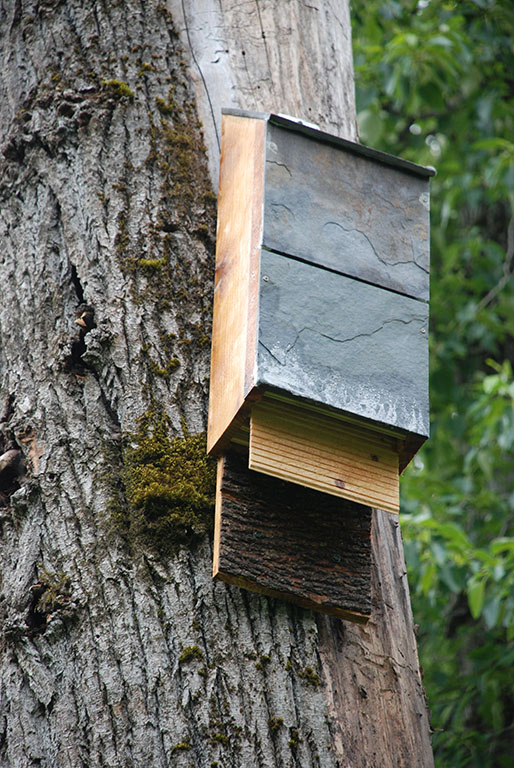
A bat house is a great way to provide them with an alternative location to roost and raise young. Usually made of plywood, a bat house is a box that is designed to attract bats. Once in the bat house, mothers will raise young and at the same time, your property can benefit from the natural insect control the bat colony will provide.
So now that you have decided to put up a bat house, the big question becomes, “How do you attract bats to a bat house?” Well as you are probably guessing, it’s not as easy as you think to actually get the bats to accept the new home especially if they are living comfortably in yours. Before excluding the bats from your home, putting up a bat house well in advance of the eviction is a good strategy that can increase your chances of them moving into the bat house.
Key Factors For a Successful Bat House
Whether you decide to build a bat house as a fun DIY weekend project or purchase one online, there are some things you will need to take into consideration. Bat houses will fail because of poor design, poor construction, and poor placement.[2] Keeping these three key factors in mind can increase the success of having bats move into your new bat house. Let’s explore further why the location, design, and construction quality of bat houses matter.
The Location of a Bat House
Picking a location for your new bat house is one of the most important steps to successfully attracting bats. Bats will be looking for a home near water, high up and that provides
A Water Source
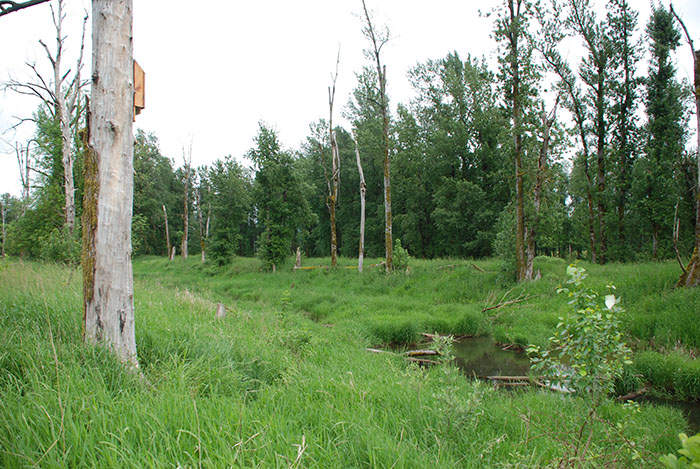
Bats are mammals, which like humans require a regular supply of fresh water. Placing a bat house in close proximity to a lake, pond or stream is key to attracting them to your bat house as they will need fresh water to drink daily.
Mounting Up High

Additionally, bats like to roost in structures that are up high. Make sure you mount the bat house 12 to 15 feet from the ground. This will give them easy access to enter and exit the roost. Mounting a bat house on a pole is the best method, however, the side of a building can be an acceptable location as long as it is not placed over windows or doors since bat guano will be dropping below the roost. Also, bat houses installed on buildings or poles are easier for bats to locate, have greater occupancy rates and are occupied two and a half times faster than those mounted on trees. [3] If you plan to mount the bat house on a tree, make sure there are not any branches or shrubs obstructing the entrance, as bats will have difficulty entering the house and may not find it suitable to occupy.
Orientation to the Sun
Bats prefer a warm location to raise young pups. The orientation to the sun plays a critical role to ensure enough heat will be absorbed by sunlight throughout the day. Place the front of the bat house in a southern or eastern direction that provides at least 6-8 hours of direct sunlight for the best results. Also, morning sunlight is preferred to help quickly warm the house from the cooler
The Design of the Bat House
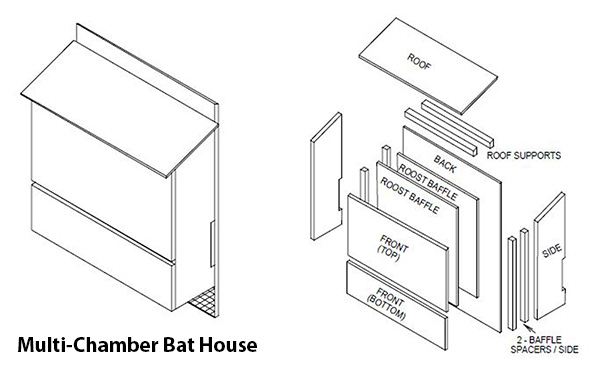
Another important factor in increasing your chances of bats moving into your bat box is picking the correct design. The capacity, length, color and chambers size is key to bats adopting your box as
Use a Larger Capacity House
A smaller house may attract bats, however, once the colony has grown, they may abandon the house for a larger space. Bat colonies can become fairly large so pick a design that can hold as lease 80-100 bats to start. If you are successful, then in a few years you can add a second house to increase the capacity of the colony.
A Longer Bat House is Better
Another important design feature is the length of the box. The most successful bat houses have roost chambers at least 20 inches tall and at least 14 inches wide. Taller and wider houses are even better.[4] Try using a design that is at least 20 inches long and incorporates a vent towards the bottom 1/3 on the box. This will provide air flow and allow microclimates within the house. If it gets too hot or cold, bats can move up or down to warmer or cooler areas of the house.
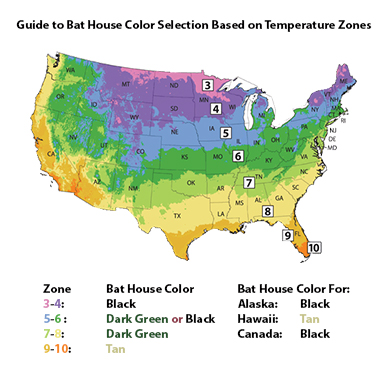
Choosing The Right Color
You should take into consideration the color of the bat house that is suitable for your climate. The color can help control the temperature inside. In warmer southern climates choose a lighter color such as tan or light green. This will reflect sunlight helping to keep bats from overheating, while darker colors such as dark green and black are more suitable in northern locations by absorbing additional solar heat ensuring enough warmth for bats in colder areas.
Small Chambers Within the Bat House
Finally, make sure your bat house incorporates smaller chambers within the house. Smaller chambers increase the capacity of the box providing plenty of surface area for the bats to grip onto. Also bats will feel safer in tighter areas that will better protect them from predators. Multi-chamber bat houses work well in providing several gaps bats can use to shelter in-between. Space the chambers 3/4-inch to 1-inch apart to provide enough room for bats to fit while keeping larger predators out.
The Quality of Construction
Simply put, when building a bat house, what you put into it is what you get out of it. If you are buying a bats house, make sure you look for the extra features as quality does matter. Going the extra mile to increase the quality of the build can be the difference for bats to occupy and stay in the house long term. Some extra features to consider are, adding roof shingles, caulking joints, scoring the interior, using quality material and painting the bat box.
Add Roof Shingles
Bats do not like to be wet, as they are warm-blooded mammals and can lose body heat when wet. Adding waterproof roof shingles helps to keep the house nice and dry. It also provides the roof area with additional insulation to retain heat. A nursing mother will go to the warmer areas of the box to roost and raise young bats.
Sealing the Cracks
Stable temperatures are very important to bats. Be sure to use a quality caulk to seal joints and cracks to ensure the bat house is free from drafts. If not properly sealed, bats may become uncomfortable and probably will abandon the shelter. In addition to retaining heat, sealing the joints will help prevent pests such as ants and wasps from invading the nest.
Scuff up the Inside with Scratches or Groves
Be sure to scratch up the interior surfaces to give bats something to cling to. some moisture may build up during the night, which makes smooth surfaces slippery. A properly scuffed or grooved surface will ensure bats do not lose grip and fall out when sleeping. Be sure to use a utility knife to scuff up the inside or incorporate groves into your design with a saw. Grooves will give bats have plenty of area’s to grab hold when roosting. Also, do not staple window screening on the inside as gripping material, as it tends to loosen or rip open over time causing bats to get stuck in between the screen which may harm or kill a bat.
Use the Right Materials
These days we are always looking for ways to repurpose materials which is a good practice, however, when it comes to building a bat house, you want to make sure you are using quality wood that is rated for exterior use and is free of pesticides. New pieces of exterior rated plywood and cedar are better choices than old scraps of lumber.
Paint Your Bat House
In the past, it was thought that you should try leaving the bat house as natural as possible, but that is just not the case anymore. Giving the house 3 or 4 coats of exterior latex paint or stain will prevent rotting, increasing the life of the structure and providing protection for bats from leaks and drafts. Paint is also a great way to add an additional layer of insulation increasing the heat retention of the box. Additionally, it’s a good idea to stain the interior with a dark color to decrease light reflection into the house from the opening on the bottom. When bats are roosting, they will prefer a darker environment.
Different Bat House Designs
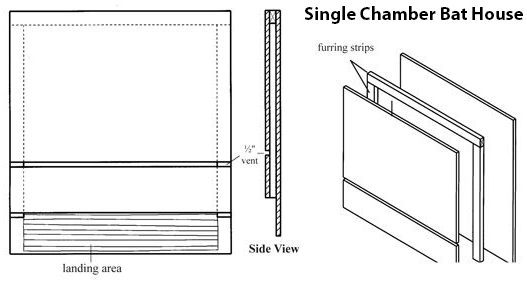
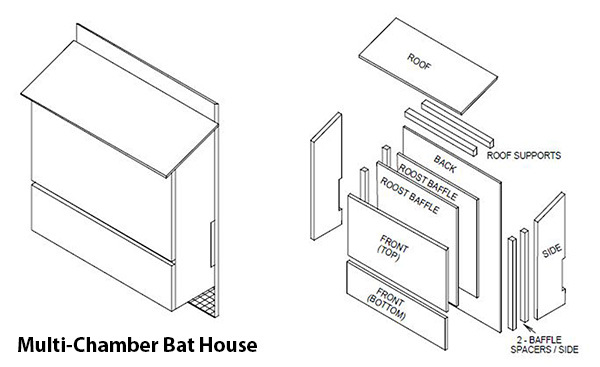
Three proven designs are the single-chamber, multi-chamber and rocket box designs. While it is better to have a multi chamber design to accommodate more bats, the single chamber is great for mounting on the side of buildings and provides a lower profile, while multi-chamber and rocket boxes often mounted on poles will provide room for larger numbers of bats.

Additional Resources
For additional information on bat house designs, check out batcon.org where they offer a wealth of information or just use these links to free design downloads of
Maintaining Your Bat House
Once you have attracted bats, you must maintain the bat houses to keep them coming back year after year.[5] Most bat species tend to migrate in colder months to warmer climates. Pests, such as wasps or mud daubers will use the box when bats are not present. Each winter, remove unwanted pests after bats have departed. Also, reapply fresh caulk, paint or stain every few years to protect the wood against the elements. Be sure to monitor the bat house to detect potential problems such as predators, overheating, wood rot, etc. Any repairs or cleaning should be done when bats are not present.
Conclusion- Getting Bats in Bat Houses
Whether you just want to attract bats to your back yard or to bridge the gap during an eviction or other habitat loss, a bat house can be a useful way to keep them around. Since the bats must move elsewhere, it is strongly encouraged to install bat houses to mitigate roost loss.[6] Bats save U.S. agriculture billions of dollars per year in pest control and around the world bats are a key pollinator of plants and crops. Please research local laws and best bat management practices before doing a bat exclusion. With a little knowledge and effort, your bat house can become a successful home for these mysterious and beneficial creatures.
If you are looking for more information on bats and the eviction process read the post on The Best Way To Get Rid Of Bats.
References
1.↑ https://www.psu.edu/dept/nkbiology/naturetrail/speciespages/little_brown_bat.html
2.↑ https://batmanagement.com/blogs/bat-roosts/why-do-some-bat-houses-fail
3.↑ http://www.batcon.org/why-bats/144-resources-issues/getting-involved/bat-houses
4.↑ http://www.batcon.org/resources/getting-involved/bat-houses/build
5.↑ http://www.batcon.org/resources/getting-involved/bat-houses/build

